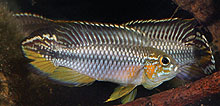WHAT'S NEW ACROSS THE WORLD
Select date in side bar to go to a What's New of previous issues
| What's New
©by Laif DeMason
Summer is now on its way out. The American Cichlid Association's annual convention came and went. Surprisingly, interest and sales for cichlids remained strong for most of this summer; certainly better than the last two summers. What is causing this renewed interest in cichlids? Perhaps hobbyists just want something new. Maybe there are new cichlid hobbyists now joining the ranks. Or maybe people just feel they are now better positioned economically to start buying again. Whatever the reason, enjoy!
Here’s “what’s new” on the cichlid scene:
|
Lake Tanganyika
Collections and exports have begun in earnest in Zambia and Tanzania. Burundi continues to export the usual bred and nearby wild caught items as well. Congo is still hit or miss, however northern Congolese items are appearing more regularly from Tanzania. Let us hope more delicate fish items will now be available from that corner of the lake.
|
WHAT'S NEW: LAKE TANGANYIKA
|

Petrochromis species are still sought by some specialized hobbyists. Pictured here, a new variety from Kasanga, Tanzania, sold as Petrochromis sp. ‘orange tail’, a close relative of the species known as “Kipili Brown”. Note the reddish color on the tail and dorsal fins.
|

Formerly (many years ago) offered from Congo, Neolamprologus gracilis has been exported again, this time from Sibwesa, Tanzania. This fish, formerly known as Lamprologus ‘palmeri’, develops long white-tipped caudal fin extensions. Note the lack of facial marks. Photo by A. Konings.
|
Lake Malawi
Interest in wild caught Malawi cichlids has increased lately! Collectors in both Malawi and Tanzania are now slowly becoming more active. Who knows, hobbyists may even start paying more for wild material, rather than the less expensive bred items.

Hobbyists that favor predatory haplochromines have been stuck as captive bred demand for such cichlids dropped years ago and thus production. Now wild caught items have arrived again. Pictured here Buccochromis rhoadesii from Ntekete, Tanzania. Often several weeks are required for males to develop their stunning colors.
|

A rarity, Mylochromis formosus, was recently exported from Tanzania again. These types of cichlids are rarely exported in any numbers so interested hobbyists should plan on buying whenever available. Again imported individuals never have any color.
|
Neotropics
What’s new in Brazil is that the government agency that is in charge of regulating the export of aquarium fishes has lifted much of the prohibitions for many pike cichlids as well as many fancy ‘plecostomus’ types. Good new for hobbyists in general!

Recently to now, pike cichlid fans had to rely on limited and seasonal wild material from places like Colombia. Pictured here, a Colombian pike shipped as Crenicichla sp. ‘red spots’. Likely it is a Crenicichla lenticulata type.
|

Now arriving from Belem, Brazil, wild-caught Apistogramma agassizii varieties. Here is the so-called A. agassizii ‘Yellow Alenquer’. Usually wild-caught Apistos take several months to show their full color. Photo by O. Lucanus.
|
Select date in side bar to go a What's New of previous issues
|





